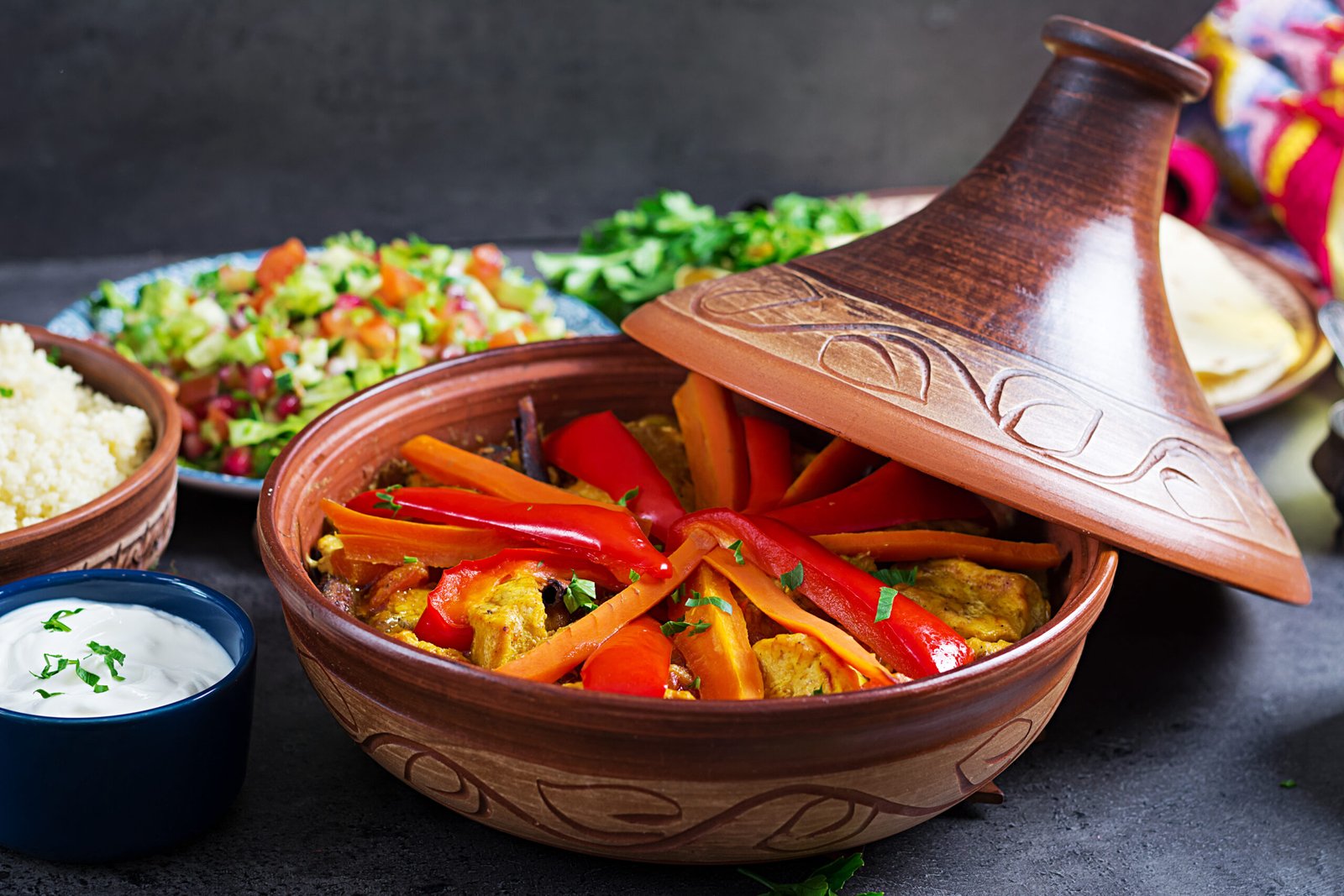This iconic Moroccan stew represents the heart of North African cuisine. Tender chicken simmers slowly with aromatic spices and vegetables in a special clay pot, filling your kitchen with irresistible aromas. If you love authentic cuisine from this region, you’ve likely encountered Chicken Tagine. In this comprehensive guide, we’ll explore everything you need to know about preparing this flavorful meal. Grab your spoon (or piece of bread) and let’s dive in!
Table of Contents
What is Chicken Tagine?
Chicken Tagine is a classic Moroccan recipe cooked in a distinctive clay pot with a cone-shaped lid. Succulent poultry simmers gently with onions, garlic, and warming spices, often accompanied by olives and preserved lemons for a salty, tangy finish. More than just a meal, it’s a comforting taste of Moroccan home cooking passed down through generations.

Essential Ingredients for Chicken Tagine
A traditional Chicken Tagine uses simple, wholesome ingredients that deliver incredible flavor. Here are the key components you’ll need:
Chicken – Bone-in pieces like thighs or legs work best for juicy results. A whole bird cut into portions also works beautifully.
Onions and Garlic – These aromatics form the foundation, adding sweetness and depth.
Spice Blend – The magic happens with spices! Common choices include ginger, cumin, turmeric, paprika, and black pepper. Some Chicken Tagine recipes incorporate saffron threads for golden color and fragrant aroma.
Preserved Lemon – These pickled citrus fruits, cured in salt and their own juices, deliver a unique tangy-salty flavor. Sliced peel adds bright citrus notes. (Fresh lemon zest or juice can substitute if needed.)
Olives – Green or purple varieties (like Moroccan picholine) contribute briny depth that pairs perfectly with lemon and poultry.
Vegetables – Many recipes include carrots, potatoes, tomatoes, or peas. These simmer alongside the meat, absorbing the delicious sauce.
Fresh Herbs – Cilantro or parsley sprinkled at the end adds color and bright flavor.
These components combine to create the signature Chicken Tagine taste – a harmonious balance of savory, spicy, and slightly sweet flavors with lemony brightness.

Step-by-Step Cooking Instructions
Cooking a Chicken Tagine is easier than you might think. You do not even need a special tagine pot – a regular big pan or Dutch oven works too (though the clay pot makes it extra authentic!). Here’s a simple step-by-step guide to making Chicken Tagine:
- Season and Brown the Chicken: First, season your chicken pieces with salt, pepper, and a bit of the spice mix (such as ginger, cumin, turmeric, and paprika). Heat a little oil in your tagine pot or pan. Add the chicken and cook for a few minutes on each side until it turns golden brown. Browning the chicken seals in flavor and gives it a nice color. Remove the chicken and set it aside on a plate for now.
- Sauté Onions and Garlic: In the same pot, add sliced onions and minced garlic. Cook them in the oil (and chicken drippings) over medium heat. Stir occasionally until the onions turn soft and lightly golden. This makes a sweet base for the stew.
- Add Spices: Sprinkle the rest of your spice mix over the onions and garlic. Stir for a minute so the spices toast and release their aroma. You will smell the wonderful Moroccan spices filling your kitchen!
- Build the Sauce: Now add a bit of water or chicken broth to the pot. This will lift all the tasty brown bits from the bottom (that’s flavor!). If you have honey or a few chopped tomatoes, you can add a little now – some Moroccan recipes use a touch of honey or tomato for sweetness and body. Place the browned chicken back into the pot with any juices from the plate.
- Add Vegetables and Flavor Boosters: Toss in your vegetables like carrot chunks or potato pieces. Also add the preserved lemon (usually just the peel, cut into small pieces) and a handful of olives. These will all simmer together with the chicken. If using fresh lemon instead of preserved, add a few strips of lemon zest and later a squeeze of lemon juice for brightness.
- Slow Cook: Cover the tagine with its lid (or cover your pan with a tight lid). Turn the heat to low and let the Chicken Tagine cook slowly. Simmer for about 45 minutes to an hour, or until the chicken is fully cooked and very tender. Slow cooking allows the chicken and vegetables to soak up all the spices and flavors. Check once or twice to make sure there’s enough liquid in the pot so nothing burns (add a little water if it’s too dry).
- Finish and Garnish: When everything is cooked, taste the sauce and add salt or pepper if needed. Sprinkle freshly chopped cilantro or parsley on top for a pop of green and freshness. Your Chicken Tagine is ready to serve!
Cooking Chicken Tagine is a slow and gentle process – low and slow is the way to go. The result is worth it: you’ll have tender chicken and a rich, fragrant sauce that’s perfect for scooping up with bread.
Why Chicken Tagine is Beloved in Moroccan Culture
Chicken Tagine isn’t just a popular dish – it’s a beloved part of Moroccan food culture. Families in Morocco often gather This isn’t just popular – it’s a cherished part of Moroccan culinary heritage. Families throughout Morocco gather around a shared pot for meals together. Here’s why it’s so loved:
Comforting and Flavorful: The aromatic spice blend creates deeply satisfying taste that warms you from within. The fragrance of ginger, cumin, and turmeric with poultry and citrus is simply mouthwatering. It’s comfort food that feels like a warm embrace.
Healthy and Wholesome: The dish packs protein and vegetables together. Spices contribute flavor plus potential health benefits (turmeric, for example, is celebrated for its properties). It’s a balanced meal in one pot.
Shared Tradition: In Morocco, eating is communal. The pot sits at the table’s center while everyone gathers around. Diners use bread to scoop meat and sauce directly from the vessel. This style makes dinner feel friendly and connected. It’s often prepared for family gatherings, holidays, or guests because it brings people together.
Rich History: Cooking in these distinctive clay pots dates back centuries in North Africa. Preparing the dish connects people to their heritage and ancient cooking methods. It’s remarkable that today’s techniques mirror those used long ago in Moroccan villages.
Whether at a restaurant or in a local home, this preparation often steals the spotlight. Its delicious taste and cultural warmth make it essential for anyone curious about the cuisine.
Expert Tips for Perfect Chicken Tagine
Want to ensure your dish turns out exceptional? Here are tips to help you create an impressive meal:
Use Fresh Spices: Aromatic seasonings are the heart of success. Use recently purchased spices for optimal flavor. They lose potency sitting too long in cupboards. Fresh cumin or ginger makes a noticeable difference.
Marinate the Meat: For enhanced flavor, marinate pieces in spices, garlic, and lemon juice several hours beforehand (or overnight refrigerated). This allows flavors to penetrate deeply. Even 30 minutes while prepping helps boost taste.
Low and Slow Cooking: Patience is crucial. Cook slowly over gentle heat. This method creates incredibly tender meat and helps all flavors meld and deepen. High heat can toughen the meat and burn the sauce.
Don’t Peek Too Often: While tempting to lift the lid and inhale the aromas, resist opening it frequently while simmering. The covered pot traps steam that cooks food gently. Opening repeatedly releases heat and moisture. Let it work its magic!
Adjust to Your Taste: Every family has its own touch. Feel free to customize. Love spice? Add chili pepper or harissa (North African chili paste) for heat. Prefer more citrus? Increase the lemon. Cooking should reflect your preferences.
Following these suggestions ensures flavorful results every time. Don’t worry without the traditional clay pot – a heavy skillet or Dutch oven with lid works perfectly. The key is gentle cooking and the magical ingredient combination.

Serving Suggestions for Chicken Tagine
One delightful aspect is how you serve and enjoy this meal. Here are suggestions for an authentic Moroccan experience:
Serve in the Cooking Vessel: If you used the traditional pot, bring it straight to the table. It looks beautiful and keeps the stew warm. Traditionally, it’s served directly from the cooking vessel. Everyone gathers around and scoops out tender meat and vegetables.
Bread for Scooping: In Morocco, this dish is commonly eaten with Moroccan bread (khobz). The bread soaks up sauce and grabs pieces of meat. No forks needed – just use bread like a little spoon, perfect for enjoying every drop! Crusty loaves or pita work well if you lack traditional bread.
Or Serve with Couscous or Rice: Many people serve the stew over couscous (tiny steamed semolina grains) or rice. While not traditionally paired together in Morocco (couscous is usually separate), it’s become popular elsewhere. The fluffy grains soak up the flavorful sauce beautifully.
Side Dishes: Consider a simple fresh salad alongside. Classic Moroccan options include tomato-cucumber salad or Zaalouk (cooked eggplant and tomato). Finish with mint tea to complete the dining experience!
Garnish: Before serving, sprinkle additional fresh herbs on top for color. Some add toasted almonds or sesame seeds for crunch and visual appeal.
However you serve it, enjoy while warm. Gather family or friends, because this dish is meant for sharing. The combination of tender meat, savory sauce, and delightful spices will have everyone requesting seconds

Delicious Variations to Try
One wonderful thing about Chicken Tagine is that there isn’t just one way to make it. There are many variations, allowing you to try different flavors. Here are a few delicious twists on the classic Chicken Tagine:
One wonderful aspect is that there’s no single way to prepare it. Many variations exist, allowing you to explore different flavors:
With Preserved Lemon and Olives: The most famous version features green olives and preserved lemon chunks. The result is tangy and savory – what many instantly envision when hearing “Moroccan stew.”
With Apricots and Almonds: This version adds sweetness. Dried apricots (or prunes) cook into the sauce, providing gentle sweetness. Toasted almonds often garnish the top. The sweet-savory combination is delightfully surprising.
Spicy Version: Love heat? Add chopped chili pepper or harissa to the stew for kick while maintaining rich flavors. Serve with cooling yogurt sauce if needed!
Vegetable-Packed: Beyond basic carrots or potatoes, load the pot with bell peppers, zucchini, or chickpeas. This makes the meal heartier and incorporates more vegetables with the flavorful sauce.
Herb-Forward: Another approach uses abundant fresh herbs. Include plenty of cilantro, parsley, and even fresh mint toward the end for green, herby fragrance alongside the spices.
Feel free to experiment. The method is flexible – with the basics (poultry, spices, and slow-cooking technique), you can try new ingredients. Each Moroccan family might have its special approach, so you can develop your signature version too!
Experience This Moroccan Treasure Yourself (Conclusion)
By now, you’ve learned about the magic of this iconic dish – what it is, how to make it, and why it’s treasured in Moroccan cuisine. The only thing left is tasting it yourself! Preparing this recipe is rewarding. As the meat gently simmers with spices, your kitchen will smell like a Moroccan spice market. The result is a meal filled with warmth and incredible flavor.
Now it’s your turn: bring Morocco’s taste into your home. Gather ingredients and try making your own version. It’s simpler than it looks, and the reward is a delicious meal that will wow family or friends. Don’t have the traditional pot? No worries – any heavy pan with a lid works. The key ingredients are love and patience.
Try this classic Moroccan recipe and savor every bite of this flavorful stew. We promise it will become a household favorite. Happy cooking! If you loved the journey, share your experience or ask questions. Enjoy your Moroccan feast, and bon appétit (or as Moroccans say, besseha – “to your health”).
Ready to get cooking? Create your own culinary masterpiece today. Your taste buds will thank you, and you’ll understand why this dish is celebrated by everyone who tries it. Bon voyage on your delicious Moroccan adventure!






